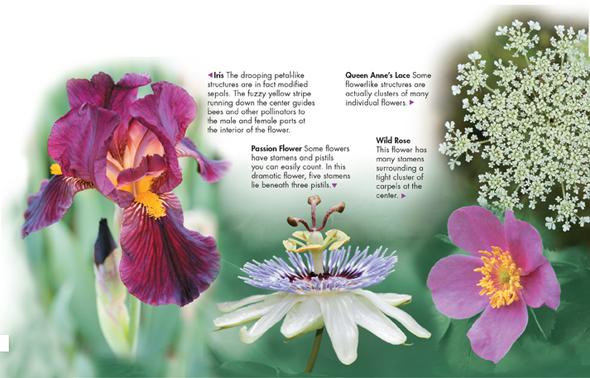Stamens Within the ring of petals are the structures that produce male and female gametophytes. The stamens are the male parts of the flower. Each stamen consists of a stalk called a filament with an anther at its tip. Anthers are the structures in which pollen grains—the male gametophytes—are produced. In most angiosperm species, the flowers have several stamens. If you rub your hand on the anthers of a flower, a yellow-orange dust may stick to your skin. This dust is made up of thousands of individual pollen grains.
Carpels The innermost floral parts are the carpels. Carpels produce and shelter the female gametophytes and, later, seeds. Each carpel has a broad base forming an ovary, which contains one or more ovules where female gametophytes are produced. The diameter of the carpel narrows into a stalk called the style. At the top of the style is a sticky or feathery portion known as the stigma, which is specialized to capture pollen. Botanists sometimes call a single carpel or several fused carpels a pistil.
 In Your Notebook Make a two-column table labeled Male and Female. Then list and define the structures that make up a flower in the appropriate column.
In Your Notebook Make a two-column table labeled Male and Female. Then list and define the structures that make up a flower in the appropriate column.
Variety in Flowers Flowers vary greatly in shape, color, and size, as shown in Figure 24–2. A typical flowering plant produces both male and female gametophytes. In some species, however, male and female gametophytes are produced on different plants. In some species, many flowers grow close together to form a composite structure that looks like a single flower, as seen in the Queen Anne's lace at right.

FIGURE 24–2 Variety Among Flowers Flowers vary greatly in structure. Form a Hypothesis How might it be an advantage for a plant to have many flowers clustered in a single structure?
dTable of Contents
- Formulas and Equations
- Applying Formulas and Equations
- Mean, Median, and Mode
- Estimation
- Using Measurements in Calculations
- Effects of Measurement Errors
- Accuracy
- Precision
- Comparing Accuracy and Precision
- Significant Figures
- Calculating With Significant Figures
- Scientific Notation
- Calculating With Scientific Notation
- Dimensional Analysis
- Applying Dimensional Analysis




